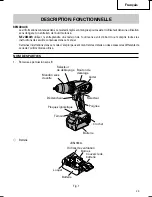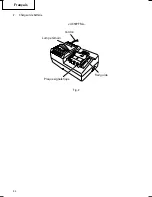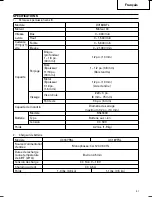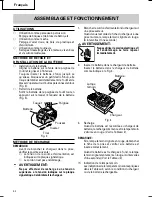
English
17
Fig. 10
7.
Tightening torque adjustment.
(1)
Tightening torque
Tightening torque should correspond in its
intensity to the screw diameter. When too strong
power is used, the screw head may be broken or
be injured.
Be sure to adjust the clutch dial position according
to the screw diameter.
(2)
Tightening torque indication (See Fig. 9)
The tightening torque differs depending on the
type of screw and the material being tightened.
The unit indicates the tightening torque with the
numbers “1, 3, 5 ... 22” on the clutch dial, and a dot.
The tightening torque at position “1” is the weakest
and the torque is strongest at the highest number.
(3)
Adjusting the tightening torque (See Fig. 9)
Rotate the clutch dial and line up the numbers “1,
3, 5, ... 22” on the clutch dial, or the dot, with the
triangle mark on the outer body. Adjust the clutch
dial in the weak or the strong torque direction
according to the torque you need.
8.
Switch operation
䡬
When the trigger switch is depressed, the tool
rotates. When the trigger is released, the tool stops.
䡬
The rotational speed of the drill can be controlled
by varying the amount that the trigger switch is
pulled. Speed is low when the trigger switch is
pulled slightly and increases as the trigger switch
is pulled more.
Line
mark
Triangle mark
NOTE:
A buzzing noise is produced when the motor is
about to rotate. This is only a noise, not a machine
failure.
9.
Rotation to Impact changeover (See Fig. 9)
The “Rotation (Rotation only)” and “Hammer
( Rotation)” can be switched by aligning
the drill mark “
” or the hammer mark “ ” with
the triangle mark on the outer body.
䡬
To make holes in the metal, wood or plastic, switch
to “Rotation (Rotation only)”.
䡬
To make holes in bricks or concrete blocks, switch
to “Hammer ( Rotation)”.
CAUTION:
If an operation which is normally performed at the
“Rotation” setting is performed at “Hammer“
setting,the effect of making holes does not only
increase but it may also damage the bit or other
parts.
10. For drilling into brick
Excessive pressing force never increases drilling
speed. It will not only damage the drill tip or reduce
working efficiency, but could also shorten the
service life of drill bit. Operate the hammer drill
within 10-15 kg pressing force while drilling into
brick.
CAUTION:
●
The motor rotation may be locked to cease while
the unit is used as drill. While operating the driver
drill, take care not to lock the motor.
●
If the motor is locked, immediately turn the power
off. If the motor is locked for a while, the motor or
battery may be burnt.
●
Too long hammering may cause the screw broken
due to excessive tightening.
11. How to select tightening torque and rotational
speed
Use
Clutch Position
Rotating speed selection (Position of the shift knob)
LOW (Low speed)
HIGH (High speed)
Machine
1 – 22
For 5/32 in. (4 mm) or smaller
For 1/4 in. (6 mm) or smaller
Screw
screw
diameter screws.
diameter screws.
tightening
Wood screw
1 –
For 5/16 in. (8 mm) or smaller
For 3/16 in. (4.8 mm) or smaller
nominal diameter screws.
nominal diameter screws.
Brick
For 1/2 in. (13 mm) or
For 13/32 in. (10 mm) or
smaller diameters.
smaller diameters.
Drilling
Wood
For 1-1/2 in. (38 mm) or
For 7/8 in. (22 mm) or
smaller diameters.
smaller diameters.
Metal
For drilling with a metal
––––––
working drill bit.
Table 6
01Eng_DV18DBFL_US.p65 copy
5/22/13, 16:43
17
Summary of Contents for DV 18DBFL
Page 11: ...English 11 2 Battery Charger Fig 2 UC18YFSL Nameplate Pilot lamp Guide rail Cord ...
Page 62: ...62 ...
Page 63: ...63 ...
















































